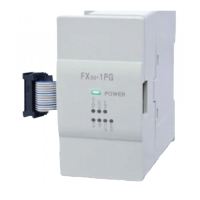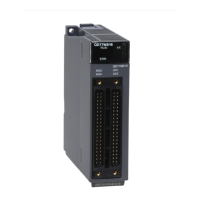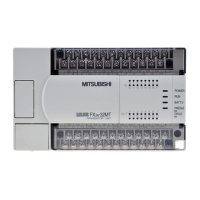4Reads/Writes Robot's Variables
How to Operate Variables 4-38
<ASCII data setting example>
• Set up the data in order from low to high byte of start address.
• Specify zero as a terminating code.
(Be compliant with the character input specification of the sequencer)
<Available character>
Available characters are compliant with robot specification. (Refer to the table below.)
[Variable data: numeric variable (Integer)]
• One word is prepared for a numeric variable and only an integer can be specified.
• Therefore, its range is between -32768 and 32767, and digits after decimal point are discarded.
[Variable data: numeric variable (Long-precision integer number)]
• Two words are prepared for a numeric variable and only an integer can be specified.
• Therefore, its range is between -2147483648 and 2147483647, and digits after decimal point are dis-
carded.
[Variable data: position, joint, and numeric (Single-precision real number) variables]
• The unit is 10
-4
mm or 10
-4
deg.
However, the number of significant figures for position and joint variable data output from the robot is
dependent on the parameter PRGDPNTM (digits after decimal point: factory default is 2 or 3 digits (it may
vary according to the robot model)), and the portion less than the significant figures is rounded off.
For example, when PRGDPNTM is two, to round off 1.2345 gives 12300 and to round off 6.7890 gives
67900.
• Only lower one word is used for the structure flag of position variable, and upper one word is a reserved
area.
• When a variable in undefined state (a variable exists but its data is empty) is read, zero is set to the unde-
fined portion of data.
• Because each component value is handled as a single-precision floating type real number in the robot, the
number of significant figures is about 7 digits.
(The value which can be expressed with 24bit when expressed in binary number is about 7 digits when
expressed in decimal number).
Category Available Characters
Program
Name
Variable
Name
Alphabetic
character
A B C D E F G H I J K L M N O P Q R S T U V W X Y Z
○○
a b c d e f g h i j k l m n o p q r s t u v w x y z
×○
Figure 0 1 2 3 4 5 6 7 8 9
○
Note1)
Note1) Only the alphabetic characters are available at the beginning of variable name. A figure is available for
second and after characters.
Symbol
" ' & ( ) * + - . , / : ; = < > ? [ \ ] ^ { } ~ | ! # $ %
××
Note2)
Note2) Parentheses "()" for specifying an array are available.
'_' (underscore)
×
Note3)
Note3) Available for second and after characters. The variable whose second character is underscore '_' is an
external variable.
White space Whitespace character
××
"1A023"
U3E0¥G10010
U3E0¥G10011
U3E0¥G10012
b15
b8 b7
b0
“1”(31H)
“2”(32H) “0”(30H)
(0H)
“3”(33H)
Shared memory addr
Specify zero as a terminating code
Set up the data in order from Low to High

